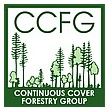PLANTING NEW WOODLAND WITH THE AIM OF CONTINUOUS COVER MANAGEMENT
Mixtures of species provide a sound basis for creating Continuous Cover forests, and utilise the varying conditions of and within the site better than single species planting. Continuous cover forests can also allow the use of a wider range of provenances of any chosen species, due to the reduced exposure to extremes of weather expected with future climate change.
Establishing a Continuous Cover forest in one planting operation on large areas of bare ground is often not easy, and will not always be possible; CCF works best when a large proportion of the trees are of relatively shade tolerant species, and most shade tolerant species survive and grow better in forest conditions than on exposed new planting sites. (Hence most afforestation projects use pioneer species that are tolerant of exposure and climatic extremes).
Because of the above, establishing a forest to be managed using a Continuous Cover approach will often need to be a compromise between the ideal long term species mixture and those that are sufficiently robust to create the initial forest conditions.
The following guidelines may be of help:
1) Well before any planting takes place dig soil pits to check the distribution of soil types present. Consider using a decision support system such as ESC (see: https://www.forestresearch.gov.uk/tools-and-resources/fthr/ecological-site-classification/) to check on species likely to be suitable in a changing climate.
2) Select one or two main species and plant 50-70% of the site with this/these species.
3) The minor species selected to occupy the remaining 30-50% of the site can be more of a gamble in terms of site suitability or the ability to survive planting on a bare site (the lower the percentage of the stand the higher the risk that can be taken).
4) Including a proportion of soil improving species as an element of the initial planting, such as alder, aspen, birch, etc. will often be beneficial.
5) Small scale intimate mixing of species in the initial planting is in most cases not recommended, as without very early low intensity thinning it is highly likely that one species will be dominated by another. A minimum group size of 6-9 trees of a single species should be used and blocks of 25-50 trees of a single species are probably a more practical number. (An upper limit is probably 100 trees, which at 2m spacing would give a circle of approximately 30m diameter). [Sizes and shapes of blocks can be varied to fit the landscape and variations in site conditions].
For more information on the design of mixtures see: www.forestresearch.gov.uk/research/establishing-robust-species-mixtures/
This paper by Gary Kerr et al. was published in the Quarterly Journal of Forestry (July 2020).
7) Planting an initial stand of high light demanding, early maturing, pioneer species, such as larch, Scots pine or birch, gives opportunities for subsequent underplanting with a more sensitive shade tolerant species that would be difficult or impossible to establish on an open exposed site.
8) Use beating-up as an opportunity to introduce alternative species (or if there is poor survival, use beating-up to correct what were possibly incorrect species selections!).
9) In exposed locations (heat, cold, wind, late frosts, etc) do not try to establish sensitive shade loving species as a major component of a new planting, unless the soil is exceptionally good. Many of the shade tolerant fir species in particular will not survive, and are better introduced to an established woodland. (Even a woodland as young as 5-10 years old will often provide significant protection for these sensitive species).
10) Shade tolerant species can usually survive and eventually push through weed competition, far better than light demanding pioneer species (as long as that they are not smothered by falling vegetation, particularly bracken). Weeds such as bramble, long grass, etc. can provide beneficial climate protection to shade tolerant species during the initial years of establishment, so do small spot weed treatment (rather than overall or more intensive weeding) if weeding is necessary.
11) Shade tolerant sensitive species are often more palatable to rabbits and deer than pioneer light demanding species. Ground vegetation, particularly bramble, and branch wood from felled woodland, provides an alternative food source and offers some physical protection around young trees, so retain where practical.
12) Make use of any advanced regeneration or natural colonisation and keep existing native species where this is practical, (particularly any rare species). Also maintain any individual veteran trees within the site, or potential future veterans. These will become elements of your future uneven aged mixture.
13) As shade tolerant species are more able to ‘sit and wait’ (for a suitable gap in the canopy to grow rapidly), planting at a higher, or variable, density can be used to create a structurally more diverse woodland quicker (and maybe cheaper?) than an initial planting followed by underplanting some years later.
14) Future management will require good long term access for harvesting to and within the area planted. This should be considered before planting (both within the stand and the roads/tracks outside the planted areas).
John Tewson 03/01/2022


